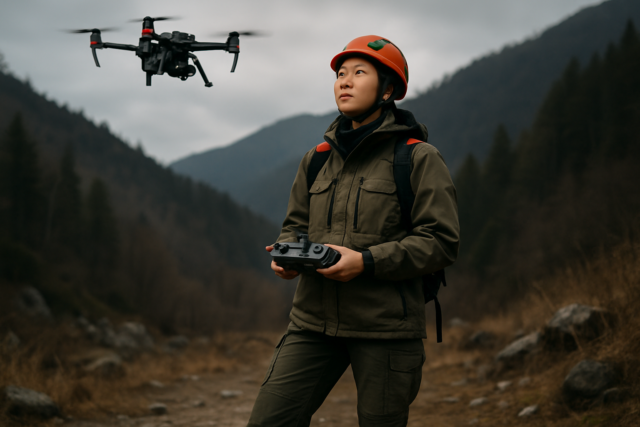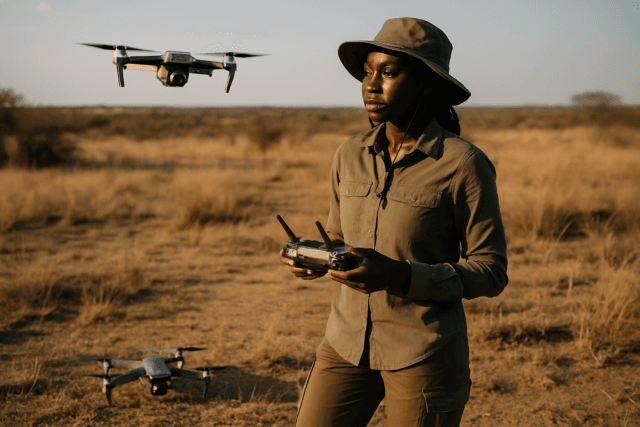The global push for renewable energy has seen offshore wind farms emerge as a crucial component in combating climate change and reducing reliance on fossil fuels. However, the development and operation of these vast installations introduce potential environmental impacts that necessitate rigorous monitoring and assessment. Enter drones, or Unmanned Aerial Vehicles (UAVs), which are rapidly transforming how these crucial environmental evaluations are conducted, offering safer, more efficient, and data-rich alternatives to traditional methods.
The Growing Need for Offshore Wind Environmental Assessment
Offshore wind power is expanding rapidly, with ambitious targets set globally to meet escalating energy demands. This expansion underscores the critical need for comprehensive environmental impact assessments (EIAs) throughout the entire lifecycle of a wind farm, from site selection and construction to operation and decommissioning. Regulatory bodies and environmental organizations require detailed data to ensure these projects coexist harmoniously with marine ecosystems. Traditional monitoring methods, often involving crewed vessels and human observers, are frequently costly, time-consuming, and pose inherent safety risks in challenging offshore environments.
Drones: A Game-Changer in Offshore Environmental Monitoring
Drones offer a transformative solution to the complexities of offshore environmental monitoring, providing a superior approach compared to conventional techniques.
Advantages Over Traditional Methods
The benefits of using drones for offshore wind environmental monitoring are multifaceted:
- Enhanced Safety: Drones significantly reduce the need for human personnel to operate in hazardous marine environments, mitigating risks associated with working at heights or in unpredictable weather conditions.
- Increased Efficiency and Cost Reduction: Inspections and surveys that previously took days or weeks can be completed in minutes or hours with drones, leading to reduced turbine downtime and lower labor and equipment costs. UAV missions also require significantly less fuel and produce lower CO₂ emissions, making them a more sustainable alternative.
- Improved Data Quality and Resolution: Drones can capture high-resolution imagery and sensor data, providing detailed insights that are often superior to what can be achieved by human observers. They can also access areas that are difficult or impossible for humans to reach.
- Non-Invasiveness: Drones provide a less intrusive way to monitor wildlife, reducing disturbance to marine mammals and birds compared to methods involving aircraft and ships.
Key Environmental Impacts Monitored by Drones
Drones, equipped with versatile sensor packages, can effectively monitor a wide array of environmental parameters and potential impacts associated with offshore wind farms.
Marine Mammal and Avian Monitoring
Drones are invaluable for surveying seabirds and marine mammals, which can be affected by noise, habitat changes, and physical structures of wind farms.
- Visual and Thermal Monitoring: High-resolution cameras on drones can detect and track marine mammals and birds, while thermal cameras can identify animals by their heat signatures, even in low light or fog.
- Acoustic Monitoring: Drones equipped with hydrophones (underwater microphones) can detect and classify marine mammal vocalizations, helping to understand their distribution and respond to potential noise impacts from construction or operation.
- Less Intrusive Surveys: Aerial drones can conduct surveys for marine mammal activity even in inclement weather, offering a less intrusive alternative to traditional ship-based observations.
Seabed and Habitat Mapping
The installation of offshore wind farm foundations and cables can alter seabed habitats. Drones, including Autonomous Underwater Vehicles (AUVs), are crucial for mapping these changes.
- Bathymetric Data Collection: Drones fitted with LiDAR (Light Detection and Ranging) technology or Multibeam Echosounders (MBES) can provide precise 3D imaging of the seabed, identifying potential hazards, monitoring seafloor morphology, and detecting scour around foundations. This data is essential for site selection, risk minimization, and ensuring the stability of installations.
- Habitat Assessment: High-resolution imagery can help assess the health of benthic habitats and track the presence of artificial reefs formed by turbine foundations.
Water Quality Analysis
Offshore wind farm construction and operation can influence water quality through sediment plumes or potential spills.
- Turbidity and Sediment Plume Monitoring: Drones can carry sensors to measure water turbidity, helping to monitor sediment dispersion during construction and its impact on marine life.
- Chemical and Environmental DNA (eDNA) Sampling: Drones are being tested for water quality monitoring, using cameras to record sunlight reflected in the water which can be compared to laboratory-analyzed samples. This aids in determining water qualities and detecting traces of environmental DNA to identify species presence.
Construction and Operational Impact Assessment
Drones provide continuous monitoring during all phases of a wind farm’s life.
- Noise Monitoring: Beyond marine mammals, drones can help assess noise levels impacting other sensitive species or habitats during pile driving and operational phases.
- Structural Integrity: While primarily for maintenance, drones inspecting turbine blades and foundations for defects also indirectly assess potential environmental impacts if structural failures could lead to ecological issues.
Drone Technologies and Sensor Payloads
The versatility of drones for environmental monitoring stems from their ability to carry diverse and advanced sensor payloads.
Visual and Thermal Cameras
High-resolution cameras provide detailed visual data, crucial for identifying species, mapping habitats, and detecting surface changes. Thermal cameras are particularly effective for detecting warm-blooded animals against cooler backgrounds, extending monitoring capabilities into challenging conditions like fog or darkness.
LiDAR and Hyperspectral Sensors
- LiDAR: Utilized for 3D mapping, LiDAR can create precise topographical models of the seabed and structures, identifying changes over time and detecting hazards.
- Hyperspectral Sensors: These sensors collect data across hundreds of spectral bands, providing highly detailed information about water quality parameters, vegetation health, and even subtle changes in seabed composition.
Acoustic Sensors
Hydrophones mounted on drones or autonomous underwater vehicles (AUVs) are critical for passively listening for marine mammal vocalizations, allowing for real-time detection and localization of species that might be affected by underwater noise.
eDNA Sampling
Emerging technologies include drones capable of collecting water samples for eDNA analysis. This method can detect the genetic material shed by organisms, providing a non-invasive way to identify species presence and biodiversity within a wind farm area.
Challenges and Considerations
Despite the significant advantages, the deployment of drones for offshore wind environmental impact assessment presents several challenges:
- Harsh Weather Conditions: Offshore environments are characterized by strong winds, rain, humidity, and saltwater exposure, which can impact drone stability, maneuverability, battery life, and data accuracy. Drones must be durable enough to withstand these conditions.
- Regulatory Hurdles: The regulatory environment for drone operations, especially for “Beyond Visual Line of Sight” (BVLOS) flights over vast marine areas, is still evolving and requires ongoing adjustments in legislation.
- Data Processing and Analysis: Drones generate immense volumes of data (images, videos, sensor readings) that require advanced software, artificial intelligence (AI), and skilled personnel for accurate analysis and interpretation.
- Communication Limitations: Remote offshore locations may have limited communication possibilities, affecting real-time data transmission and drone control.
- Battery Life: While improving, battery life can still be a limitation for long-duration missions, especially for smaller aerial drones.
The Future of Drone-Based Environmental Monitoring
The future of drone-based environmental monitoring for offshore wind farms is bright, driven by continuous technological advancements.
- AI and Machine Learning Integration: AI algorithms are increasingly being used to analyze drone-collected data, automatically detect anomalies, identify species, and even plan optimal flight paths. This enhances efficiency and accuracy, reducing the need for extensive human input.
- Increased Autonomy and Swarm Technology: Drones are becoming more autonomous, capable of independent decision-making during complex inspections and early-stage damage detection without human intervention. Future developments may see swarm technology, where multiple drones work cooperatively to cover larger areas more quickly.
- Expanded Sensor Capabilities: Research continues into integrating more sophisticated sensors, including advanced ultrasonic and acoustic emission systems for internal damage detection, further broadening inspection and monitoring capabilities.
- Integration with Uncrewed Surface Vessels (USVs) and AUVs: The combination of aerial drones with uncrewed surface vessels and autonomous underwater vehicles allows for a comprehensive, multi-layered monitoring approach, gathering data from the air, surface, and subsea environments. These integrated systems can provide continuous, real-time metocean data, ocean mapping, and persistent ecosystem monitoring.
- Cargo Delivery: Beyond monitoring, drones are being tested for transporting spare parts and tools to offshore turbines, further streamlining operations and reducing emissions from crew transfer vessels.
Conclusion
Drones are undeniably revolutionizing the assessment of environmental impact for offshore wind farms. By offering safer, more efficient, and ecologically friendly data collection, they are enabling developers and regulators to gain a deeper, more comprehensive understanding of how these critical renewable energy installations interact with the marine environment. As technology advances and regulatory frameworks mature, drones, powered by AI and integrated with other autonomous systems, will become even more indispensable, ensuring that the expansion of offshore wind power proceeds sustainably and responsibly.





